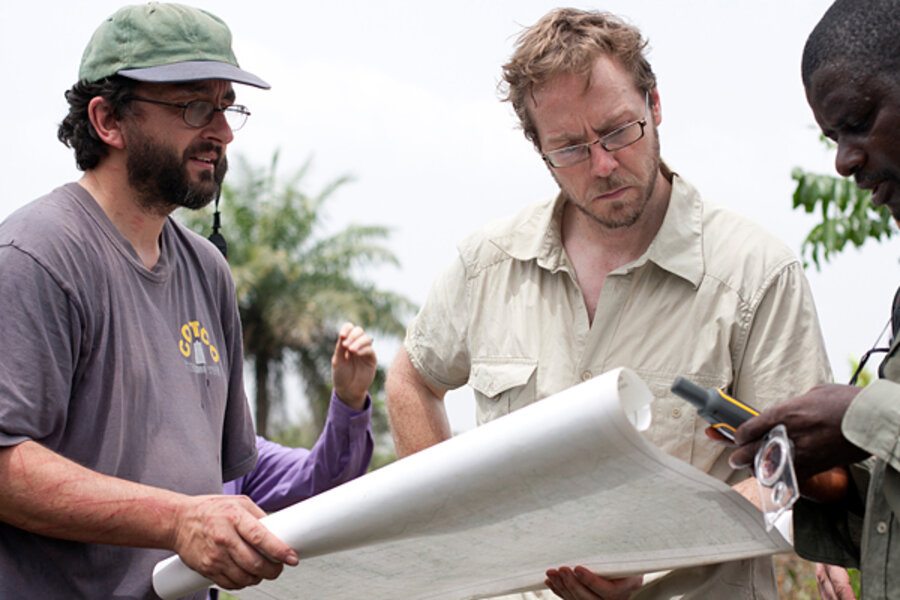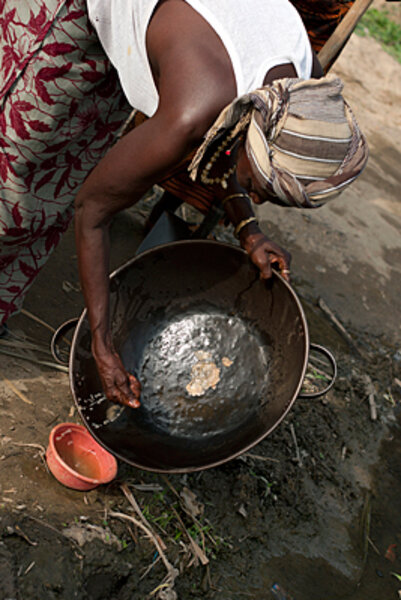Sierra Leone's dilemma: There's gold under those trees
Loading...
| Freetown, Sierra Leone
It’s an age-old question, and one that’s been played out countless times in cities and countries around the globe: What happens when conservation and economics collide?
Here in Sierra Leone, a small, impoverished nation that’s still tending the wounds of a protracted civil war, that question is just now coming to a head. And in one recent instance, the answer was clear: Economics wins.
Sierra Leone has been working hard to attract foreign investment since the war ended in 2002. The West African nation has a lot to offer potential investors, including rich seams of iron ore, rutile, diamonds, and gold. But the country is also rich in pygmy hippos, chimpanzees, lowland rainforest, and mangrove swamps.
Striking a balance between those two national assets – mineral resources and flora and fauna – is a delicate task, especially in Sierra Leone, where the laws are often murky and enforcement of them is weak.
That’s certainly the case in the Kangari Hills, a 21,000-acre forest reserve that lies in the central region, about a six-hour drive from the capital, the last two on rough dirt roads. It’s here that Cluff Gold, a British company, has found a hefty deposit of gold beneath the surface. The company has set up a base, and they’re ready to build their mine.
Rock piles as boundaries
And that’s where things get complicated. The Kangari Hills have been officially protected since the 1920s, when Sierra Leone was still a British colony. When the forest reserve was established, its boundaries were marked by piles of stones and cleared pathways through the jungle. But those boundary lines weren’t maintained during the decades of government mismanagement in the 1970s and '80s, or during the war in the '90s. Today, it’s not at all clear where the actual boundary of the reserve lies.
But one thing is certain: There is a lot of gold in and around the Kangari Hills, and Cluff Gold wants to mine it.
“You have a fairly vague description of a forestry reserve boundary that was marked by piles of stones in an area that’s full of piles of stones, so that makes it a bit tricky to try and recover,” says John Donaldson, an academic and international boundary expert who was brought in by the United Nations to reestablish the outlines of the reserve.
Mr. Donaldson and his small team determined that parts of Cluff Gold’s mining site lay within the Kangari Hills Forest Reserve. Donaldson presented the findings to a government steering committee in February. Two months later, the committee issued Cluff its environmental license, despite the evident overlap.
Cluff Gold claims to have already found 3 million ounces of gold in and around the Kangari Hills. With gold prices hovering near record highs – gold was trading at $1,742 per ounce today – those hills are worth more than $5 billion. That’s more than twice the value of the entire Sierra Leonean economy.
“What Cluff will be producing per annum, probably the whole of Sierra Leone hasn’t produced since [gold] production started here,” says Abdul Fofana, a senior geologist for Cluff Gold, adding that the Cluff mine would be the country’s first industrial-scale gold operation.
A boon for meager budget
Tax revenue from the export of all of that gold could mean more money for schools, roads, hospitals, and the meager power grid in this infrastructure-poor country. The total government budget in Sierra Leone last year was just $475 million – or about one-fifth the size of the budget of the city of Boston.
But all that gold doesn’t come without a price. The mining process will require the use of harsh chemicals like cyanide and caustic soda, some of which will be collected in an open tailings pond that will sit just next to a local village. And the mine will leave a huge scar on the land.
“The mining itself will be predominantly open pit,” says Mr. Fofana of Cluff. “We’re going to drill and blast to remove material, remove waste, and then we’re going to use excavators to move the ore.”
Environmental impacts
The impact will certainly be felt in the Kangari Hills, a nearly 90-year-old protected area that serves as a critical habitat for forest elephants and chimpanzees, both of which are endangered. Contiguous clumps of forest aren’t nearly as common as they used to be in Sierra Leone. Today, the country has just 4 percent of its original forest cover, largely as a result of deforestation caused by fuel wood collection, charcoal burning, and slash-and-burn agriculture.
And deforestation is a dangerous business in Sierra Leone, a country that gets a staggering 12 feet of rain every year, almost all of which falls in the four months of the rainy season. Flash floods, heavy siltation, and landslides are all too common in areas that have been cleared of trees. The Cluff mining site, which will denude an entire section of hills, lies just above the small village of Baomahun, where locals depend on streams for their drinking water.
“I think those reserves must be respected,” says Aminata Lamine Kelly, a regional director for the Network Movement for Justice and Development, a Sierra Leonean nongovernmental organization. Allowing mining in Kangari will set “a worrying precedent,” Ms. Kelly adds. “I don’t think this will be a wise decision for our government just to give away that much because of the exploitation of gold.”
But the steering committee made its decision back in April, and the project is all set to move ahead. Cluff Gold expects to begin production in 2014. The tax revenues should begin flowing soon after.
“We are not going to stifle major economic areas because of forests,” says Jonathan Sharkah, Sierra Leone’s minister of Mines and a member of the committee that made the decision. “We have a lot of forests in this country. We can give up a few and still we have a lot of forest.”
Jatou Jallow, the head of Sierra Leone’s Environmental Protection Agency and another member of the steering committee, takes a more measured view.
“If we look at the economic benefits of this company to this country, I am sure that it is reasonable for there to be some concessions,” says Ms. Jallow. “We want to improve and enhance the lives of our people,” she adds, “and exploiting our God-given natural resources is an avenue where we can … alleviate poverty in this country.”
* This reporting was made possible by a grant from the Fund for Investigative Journalism








